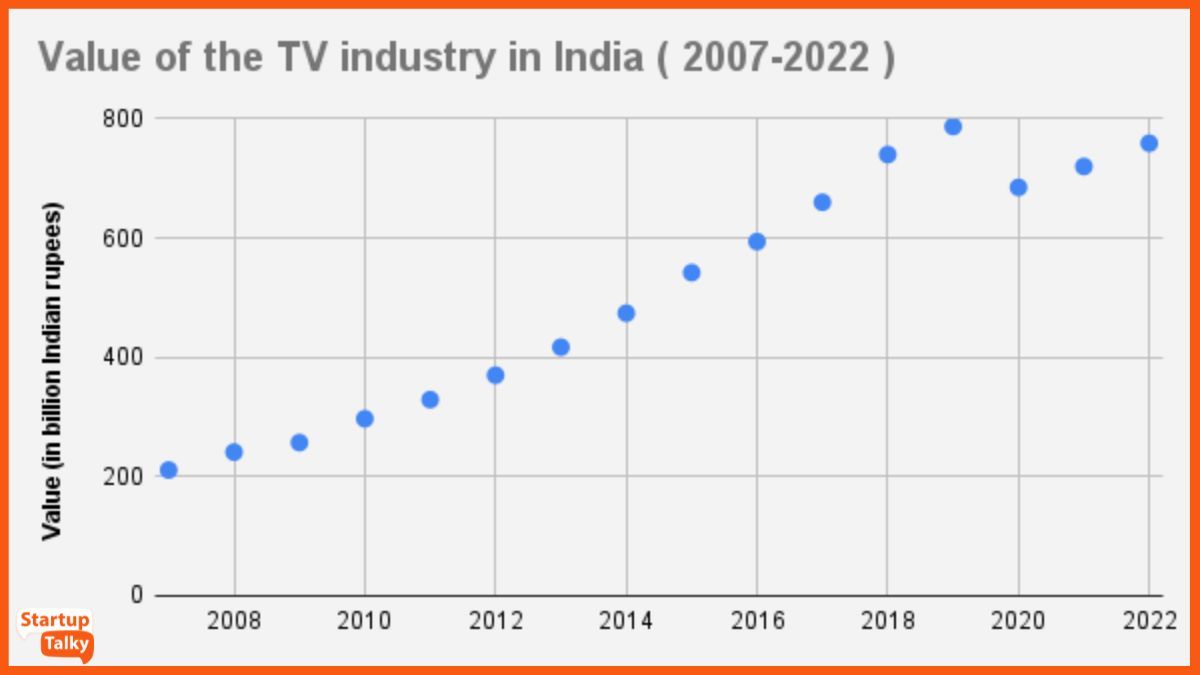Revenue Generation Model of Television Channels
🔍Insights
The Indian Television Industry produces thousands of programs in many Indian languages with the Hindi, Tamil and Telugu factions of the industry being the largest. In 2021, the Indian Television Industry was worth INR 720 billion and is estimated to reach INR 826 billion by 2024.
Emergence & Expansion of the Television Industry
Television emerged on the Indian market in 1959 as an experiment which offered two-hour programs for a week. It soon garnered popularity and by the 1970s television centres were opened in other parts of the country. The year 1976 saw Doordarshan emerging as a separate government department and in 1982 it telecasted the 9th Asian Games. The 1990s saw the television industry expand with the emergence of private television channels. It began after CNN broadcasted the Gulf War. STAR (Satellite Television Asian Region), which was based in Hongkong entered into an agreement with an Indian company giving birth of Zee TV. Several other channels came into existence during this time including regional channels and international channels like CNN, BBC and Discovery offering different categories of entertainment to a wide variety of audience. This expansion also gave rise to DTH (Direct To Home) cable operators. By the year 2016, Indian Television boasted of 857 channels of which 184 were paid channels.
Television has become an integral part of people’s daily lives. The popularity of the medium is due to its capability to cater to the needs of its audiences through various shows of different genres telecasted through various channels.
Revenue Generation Model
As with any commercial enterprise, television industry operates with the basic idea of generating revenue and posting profits. The various channels generate revenue from three basic streams – Advertisements, Subscription Services, Sponsorships & Product Placements, Licensing owned Content and Re-transmission Fees.
1. Advertisements
Television channels sell airtime and slots to advertisers who wish to showcase their products or services during commercial breaks. The slot and airtime rates depend on the time and on the popularity of the show as well as the time-length of the advertisement itself. Advertisements broadcasted during prime time cost more than those which are broadcasted at low viewership slots, like mornings or early evenings. Even the TRP (Television Rating Points) ratings of the show affect the airtime rates.
2. Subscription Services
This is a two-pronged process. Some television channels are made available to subscribers, by DTH operators, on payment, which could be monthly or annually. A part of this subscription fees goes to the channel itself. This model of revenue generation is largely volume based.
3. Sponsorships & Product Placements
Television channels are a high interest sponsorship venue due to their wide and deep audience penetration. They receive funding from sponsors for programming. A high revenue is also generated from specific advertiser product placement within their shows.
4. Licensing Owned Content
Television Channels also produce and distribute content like programs or movies and generate revenue by licensing or outright selling the rights to other networks or streaming devices.
5. Re-transmission Fees
Television channels charge fees from cable distributors and satellite operators to allow them the right to retransmit their local signals. This can happen for a program that sees high demand.
Specific coverage of live events like sports, concerts or award shows are also a high revenue generating stream for television channels. Such events attract large audiences which, in turn, translate into higher advertisement rates. Another minor, however, effective revenue generation source is the internet. Television channels stream their program episodes via YouTube and generate income on the number of times the program is viewed. This also works as an advertisement for the program and the channel and can increase their audience reach.
Trends in the Television Industry
The delivery of television programs to the audience has undergone a huge change, especially in the recent years. What was delivered through relied antennas has switched to dishes, distribution through cable networks and direct broadcast satellites. Through the use of Internet Protocol Television, programs are available to watch on mobile phones.
Conclusion
The television industry is fiercely competitive and its revenue generation is heavily dependent on capturing the viewers attention and sustaining it. Effectively, it is that attention that the channels sell to the advertisers. While the TV channel landscape continues to evolve with the rise of digital media and streaming services, the fundamental principles of generating revenue through high-quality content and effective advertising remain constant.

- As per industry estimates, the Indian TV advertising market was valued at approximately 35,000 crore INR (~$4.7 billion) in 2021.
- The television revenue is expected to grow at a CAGR of 4-5% and reach Rs 826 billion by 2024, according to EY FICCI M&E 2022 report.
- The report says, the ad revenue of TV is expected to become Rs 394 billion in 2024.
- Revenue from subscriptions for TV channels is expected to reach Rs 415 billion in 2023.

FAQs
How do free TV channels make money?
Free Tv channels earn revenue by displaying ads between the shows.
How much does it cost to start a TV channel?
To start a non news channel the net worth of the company should be around 5 crores.
What is the benefit of high TRP?
If a channel has high TRP they can charge a higher amount from advertisers.
What is the revenue model for TV Channels?
The two key methods of revenue for TV Channels are:
- Subscriber fee
- Advertising
How many TV channels are there in India?
There are 850 TV channels in India.
What is full form of TRP?
TRP stands for Television Rating Point.
Who calculates the TRP for Television Channels?
TRP is calculated by Broadcast Audience Research Council using “BAR-O-meters".
Must have tools for startups - Recommended by StartupTalky
- Manage your business smoothly- Google Workspace






